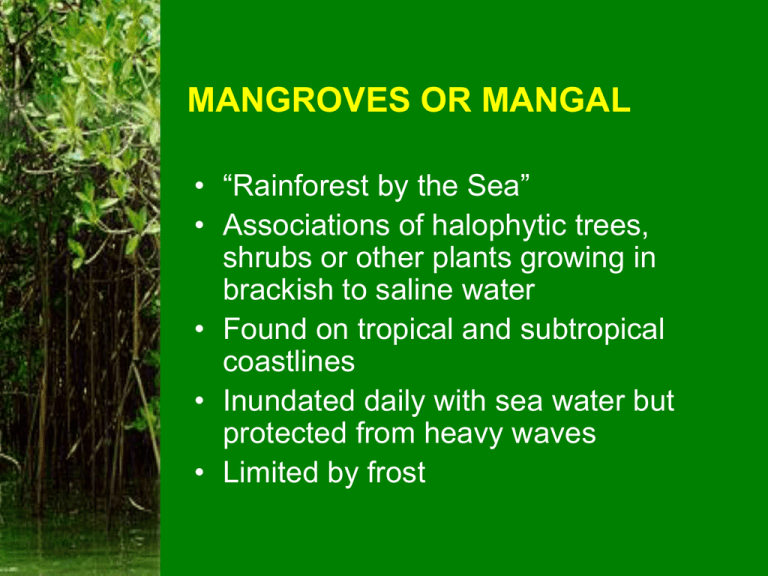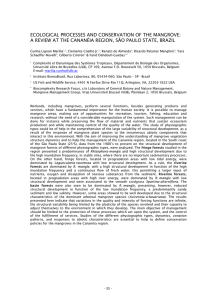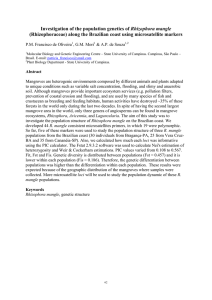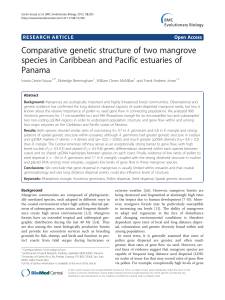mangrove4
advertisement

MANGROVES OR MANGAL • “Rainforest by the Sea” • Associations of halophytic trees, shrubs or other plants growing in brackish to saline water • Found on tropical and subtropical coastlines • Inundated daily with sea water but protected from heavy waves • Limited by frost ADAPTATIONS • Salinity Control – salt exclusion or secretion • Viviparous seedlings • Prop roots and pneumatophores SALINITY • Facultative halophytes – found over a wide range of salinity; 10-60 ppt • Competitive advantage over freshwater species • Survive wide annual fluctuations MANGROVE COMMUNITY TYPES Fringe Mangroves •Overwash island •Shoreline Rhizophora mangle Red Mangrove, Mangle Rojo •Opposite, evergreen leaves & white flowers •Prop roots – grounded and ungrounded •Viviparous Avicennia germinans Black mangrove, Mangle negro •Opposite, leathery leaves; yellowish to dark green above, downy beneath with salt glands •pneumatophores Laguncularia racemosa White mangrove, Mangle blanco •Leathery, opposite leaves with rounded tips and 2 salt glands on petiole Conocarpus erectus Buttonwood, Mangle de botón •Leaves alternate, elliptical, with a row of salt glands along the rachis ZONATION MHW SUCCESSION • Peat accumulation balanced by tidal export, fire and hurricanes • Advance and retreat of zones according to the fall or rise of sea level • Stressed or youthful ecosystems – Slowed or arrested succession – Low diversity – Open nutrient cycles FACTORS CONTROLLING PRIMARY PRODUCTIVITY • Tides and water chemistry intertwined – Transport of oxygen to roots – Removal of toxins and salt from pore water – Control of sediment accumulation – Regeneration of nutrients lost from root zone • Water chemistry alone – Pore water salinity – Concentration of nutrients ORGANIC EXPORT • 50% of productivity exported as detritus • May supply as much as 52% of the fixed carbon available for secondary productivity • Detritus primary food source to invertebrates and forage fish ANIMALS ASSOCIATED WITH RED MANGROVE PROP ROOTS • Roots provide nursery areas and solid substrate • Proximity to and extent of exchange between coastal waters, especially coral reefs • Presence or absence of algae • Tidal amplitude • Competitive interactions • Predation, particularly intraguild predation http://jrscience.wcp.muohio.edu/html/tropecoimages.html#Anchor-mangroves GENERAL FAUNAL TYPES • Adjacent to coral reefs, e.g. Carrie Bow Cay, Belize – Sponges, tunicates, hydroids, anemones, polychaetes • Isolated from reefs – Isopods, barnacles, molluscs, algae, amphipods Laguna Boca Paila •Water very clear • Bottom either covered with Halodule wrightii, Ruppia sp., or leaf litter, otherwise sand/shell • Tree heights 10-22 ft. • Protected embayment with only a small inlet to Caribbean ABUNDANCES OF HIGHER TAXA Isopod 6% Tanaid 4% Amphipod 86% Bivalves 3% Polychaete 1% DOMINANT SPECIES •Amphipods Hyale plumulosa Ericthonius brasiliensis Parhyale fascigera •Isopods Sphaeroma terebrans •Algae Polysiphonia sp. Anotrichium tenue Bostrychia montagnei Batophora oerstiddi EFFECTS OF ALGAE TRENDS IN INVERTEBRATE DENSITY AND BIOMASS IN RELATION TO ALGAL BIOMASS 5 4 3 2 1 0 -1 Invertebrate Density (ind./100cm2) in hundreds Invertebrate Biomass (g/100cm2) Algal Biomass (g/100cm2) ALGAE-DOMINATED ROOT Many small, motile invertebrates, especially amphipods •Low diversity •High abundance BARE ROOTS •Boring isopods & bivalves •Balanoid barnacles •Low diversity •Low abundance LAGUNA BOCA PAILA: PROPOSED FOOD WEB FOR R. MANGLE PROP ROOT COMMUNITY Detritus Green algae Vaunthompsonia minor Phytoplankton Primary producer Cyclaspis sp. Pachygrapsus gracilis Mugil cephalus Hyale plumulosa Nereis pelagica Mytilopsis leucophaeata Ericthonius brasiliensis Nodolittorina lineolata Cassidinidea ovalis Littoraria angulifera Cyathura cubana Macrobranchium acanthurus Lutjanus apodus Ischadium recurvum Copepods Ostracods Palaemonetes vulgaris Nematode Bathygobius mystacium Gobiosoma bosc Callinectes portunus Concrete relationship Sphoeroides testudinus Inferred relationship Eleotris pisonis Sphyraena barracuda Terminal carnivore INTRAGUILD PREDATION • Common in communities with many interference competitors • Typical in mangrove prop root communities • Defined as killing and eating of competitors • Interference competitors at Laguna Boca Paila: – Lutjanus-Callinectes – Sphyraena-Lutjanus – Palaemonetes-Bathygobius BIRDS FISH IMPORTANCE TO LOCAL COMMUNITIES • Traditionally managed by local communities – Food, medicine, tannins, fuel wood, construction materials – Sustainable, dependable, cultural • Minimize property damage & deaths due to tropical weather • Useful for treating effluent CONSERVATION ISSUES • Among the most threatened habitats in the world – Coastal development may result in long-term exposure or flooding – Timber & charcoal industries – Expanding shrimp aquaculture • Considered wastelands or useless swamps






